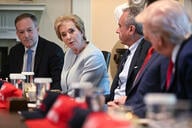You have /5 articles left.
Sign up for a free account or log in.
Much has been said and written in recent years about how rising college tuitions and insufficient need-based financial aid are combining to diminish access to higher education for students from low and moderate income backgrounds. Now an independent federal panel has tried to quantify exactly how many students have failed to get a bachelor's degree because of those factors, and the numbers are striking.
In "Mortgaging Our Future: How Financial Barriers to College Undercut America's Global Competitiveness," the Advisory Committee on Student Financial Assistance, a nonpartisan panel that advises Congress, estimates that in the 1990s, between 800,000 and 1.6 million low and moderate income high school students who were both academically qualified for and intent on attending a four-year college did not go on to earn a bachelor's degree. In this decade, the panel concludes, another 1.4 million to 2.4 million similarly situated students face the same fate. The panel's report describes the formula used to produce its "loss" estimates and projections (which is described below) as "extremely conservative."
"These bachelor's degree losses are an unmistakable signal that our nation has yet to make the full investment in student aid necessary to secure our economic future -- a dire warning that we are requiring millions of students to mortgage their future and ours as well," the panel writes in its report, which the advisory committee presented to Congress this week, drawing contrasting reactions from leaders of the two parties (more on that later).
Much of the analysis contained in the advisory committee's report will be familiar to those who follow issues of college access. It offers a slew of statistics showing how much likelier students from wealthier households are than those from lower socioeconomic classes to find a place in college, and joins the long list of recent reports tying America's future economic competitiveness globally to its ability to educate increasing numbers of its citizens in the future.
But what's really new in the report, and likely to attract both attention and some scrutiny, is its attempt to quantify the educational inequality based on socioeconomic status.
The advisory committee uses a multi-step process to come up with its estimates of the number of students who are "lost." Using two federal databases -- which examine the educational outcomes of eighth graders in 1988 and 2000, respectively -- it first identifies those students who graduated from high school "college qualified," based on the level of math they completed. (The range it produces of those affected -- for instance, the conclusion that between 800,000 and 1.6 million students were excluded in the 1990s -- emerges because it looks both at those students who successfully completed algebra II and those who completed trigonometry.)
The report then whittles down those college-qualified students by looking at those who said in 10th grade that they wanted to get a bachelor's degree, and later reported in 12th grade that they planned to get a degree. The report then examines the "melt" between those who said in 12th grade that they planned to get a degree and those who actually had enrolled in a four-year college within two years. It then counts how many students had failed to earn a four-year degree within eight years of graduating high school. That amounts to between 1.3 million (based on those who took trig in high school) and 3.7 million students (those who took algebra II) in the 1990s and 2.2 million and 5.6 million in this decade.
Left at that, the figures reveal only how many college qualified and ambitious students did not earn a degree. But since students fail to move through the education system for many reasons, and the advisory committee sought to zero in only on those for whom finances were the deciding factor, the report goes a step further. It counts as having been turned away for financial reasons only the proportion of students that exceeds the rate at which similarly situated middle income students also failed to earn a degree.
"These estimates are extremely conservative, reflecting only those losses that occur among low- and moderate-income college-qualifed high school graduates and only to the extent that they are unable to enroll and persist in college at the same rates as their middle-income peers," the report says.
"These bachelor's degree losses will be difficult, if not impossible, to stem through strictly non-financial means," the report says. "Although academic preparation appears to have improved, early information and student expectations to complete college have certainly expanded, and financial aid forms and processes have been greatly simplified over the last decade and a half, bachelor's degree completion rates by family income show no sign of improving. Financial aid barriers in the form of record-level work and loan burden caused by rising college prices and insufficient need-based grant aid continue to undermine advances in other areas."
The findings lead the advisory committee to recommend several steps to political leaders and policy makers, including:
- Reinvigorating the "access and persistence partnership" to increase need-based aid from all sources.
- Restraining increases in the price of college and offset necessary increases with need-based aid.
- Moderating the trend -- at all levels -- toward merit-based aid and increasing reliance on loans.
- Reducing financial barriers to transfer from two-year to four-year colleges.
- Strengthening early intervention programs for low and moderate income middle school students.
- Investing in efficient and productive remediation in college.
The advisory committee presented its findings to members of Congress this week, and the two parties drew from the report what they wanted to.
Democratic leaders, who also held a news conference Wednesday at which they decried Republican policies on student aid and vowed major changes if they take over Congress in November's elections, said the advisory committee's report "focuses on how financial barriers are keeping millions of qualified students, especially low and moderate income students, from going to college." That report and another released Wednesday by the Campaign for America's Future, a group of prominent Democrats, "show that the skyrocketing costs of college continue to gouge the wallets of students and working families," said Rep. George Miller, the senior Democrat on the House Committee on Education and the Workforce.
"Students are graduating with bigger college loan debts than ever before, and many can’t afford to go to college at all. These rising costs, coupled with stagnating family incomes and dwindling financial aid, have led to a serious crisis – one that hits low-and moderate-income students especially hard."
Republican leaders of the House Committee on Education and the Workforce, however, read the report differently. Rep. Howard P. (Buck) McKeon (R-Calif.), the panel's chairman, said it offered "further evidence in favor of a renewed focus on hyperinflation in college costs." He said the report backed changes he and other Republicans have proposed to require colleges to report more information about their costs, aimed at helping "families overcome the chief barrier to college access: the ever-present increases in college costs."





